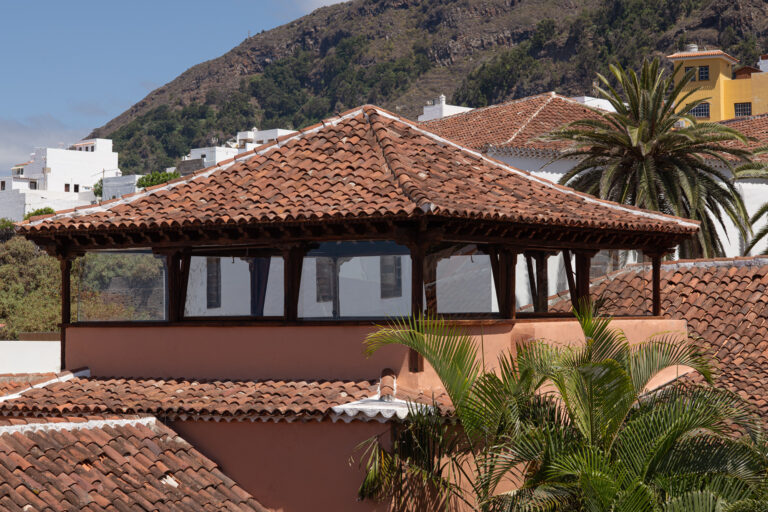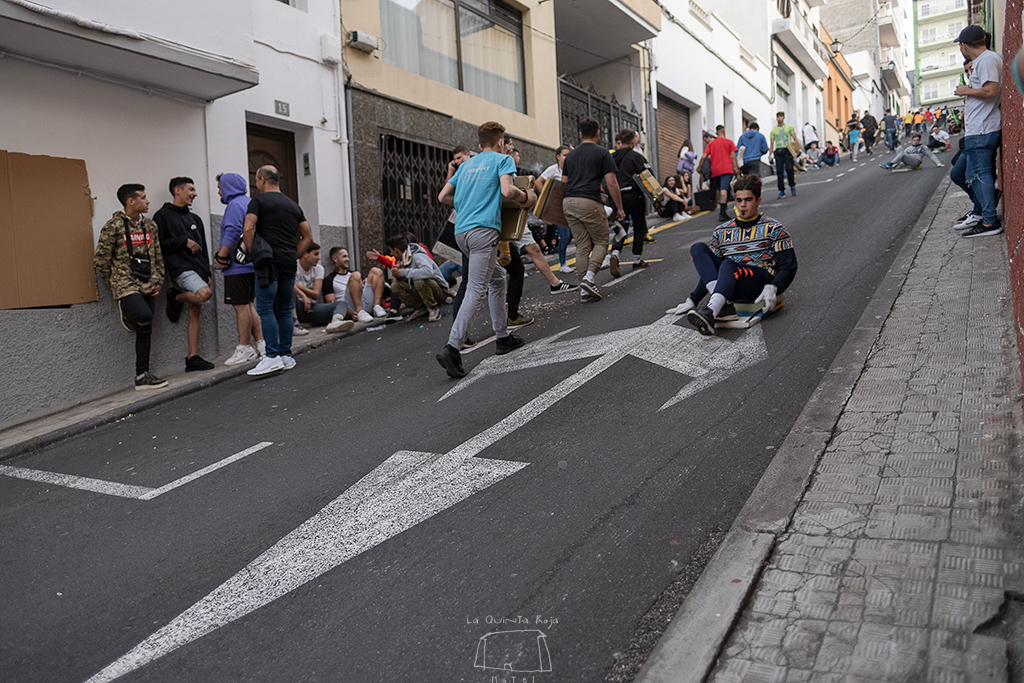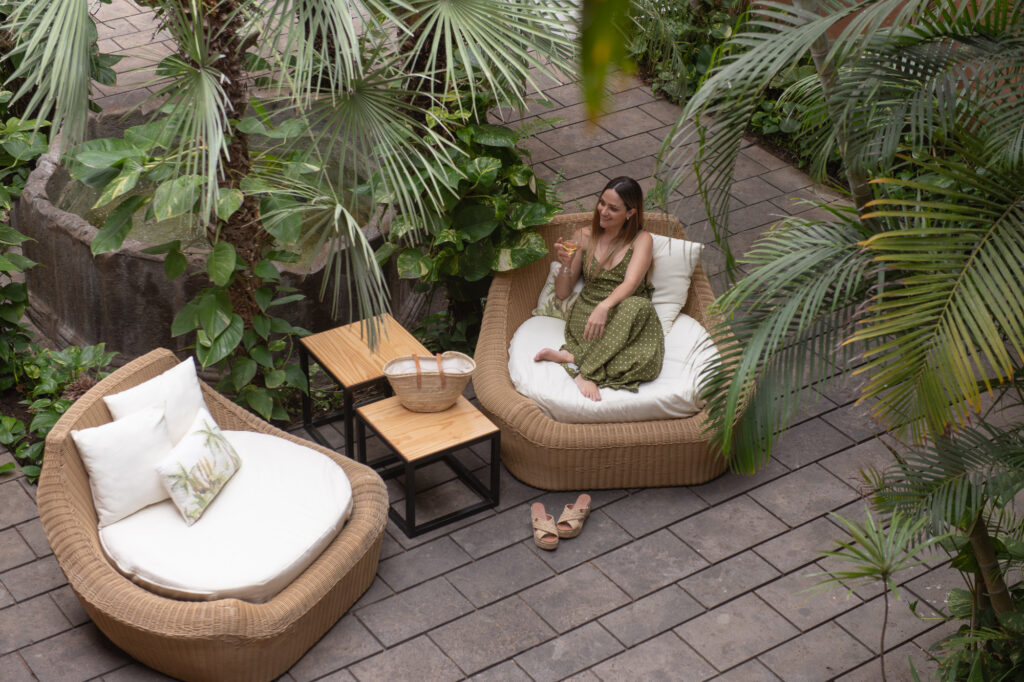Every time we uncork a bottle of Canary wine at La Quinta Roja, we are savoring centuries of history, unique aromas that evoke the ocean, volcanoes, and trade winds. A liquid testament to the cultural and natural richness of the Canary Islands.
“Canary wine,” world-renowned between the 16th and 18th centuries, found one of its epicenters in the port of Garachico. From there, galleons loaded with wine set sail for the New World, Africa, or Northern Europe, where it was considered a highly prized commodity.
Gazing out from the lattice window of the Casa Palacio del Marqués de La Quinta Roja, with a glass of Canary wine in hand, it’s easy to let the imagination soar and travel back to those times when one could watch the hustle and bustle of ships arriving at the port or departing for distant lands.

Today, we invite you to discover what a glass of Canary wine holds: a unique blend of history, landscape, and singularity.
A Brief History of Wine in the Canary Islands
The Canary Islands’ winemaking tradition began throughout the 15th century with the arrival of the first settlers from different regions of Spain and Europe, who brought among their belongings vine cuttings and the cultivation methods of their regions.
The peculiarities of the soil and climate of the islands caused the imported grape varieties to gradually adapt to the new conditions, resulting in the emergence of new endemic varieties. Growers also had to adapt their cultivation methods, creating unique techniques such as the braided cordon, used to train Malvasia vines.
Canary Wine, the Precious Wine of the Canary Islands
Among all the introduced grape varieties, aromatic Malvasia, originally from the island of Candia (modern-day Crete), was the star. Along with the Vidueño grape, it made Tenerife the largest wine exporter in Europe during the 16th and 18th centuries, exporting up to 20 million liters annually.
With Malvasia, the legendary “Canary Wine” was born, a sweet wine cherished at the finest tables in Northern Europe and America, even mentioned by Shakespeare in one of his works and used to celebrate the signing of the United States Declaration of Independence.
Our wines not only quenched the thirst of crews en route to the New World but also served as an economic and cultural driver, traveling alongside Canary silks crafted by the skilled hands of the island’s women.
Garachico and the Wine Spill: A Historical Episode

The port of Garachico was the main gateway for Canary Islands wines. The town and port were bustling with activity, attracting merchants from other parts of Spain and Europe.
The economic pressure exerted by the Canary Company, led by British exporters, created tensions with local winegrowers. In 1666, these tensions culminated in an act of resistance known as the “wine spill.”
During the night, a group of masked individuals entered British warehouses and poured thousands of liters of Malvasia wine onto the streets of Garachico. Viera y Clavijo described this event as “one of the strangest floods ever recorded in the annals of the world.” This incident reflected the struggle of local winegrowers against monopolistic practices and the low prices imposed by the British. A sculpture located on Garachico’s avenue pays tribute to this historic episode.

Lights and Shadows in the History of Canary Wine
Despite its success, the Canary Wine trade faced numerous challenges. Restrictions such as those imposed by the Council and the House of Indies, the English prohibition under the Staple Act, which favored Madeira and Port wines, and the eruption of the Trevejo volcano in 1706, which destroyed the port of Garachico, all contributed to the decline in trade.
Pests like oidium and mildew nearly wiped out the vineyards in the 19th century, and the quality of the wine diminished. However, the resilience of producers allowed the sector to rebound by the late 20th century, ushering in a new era for Canary wine, with the revival of the industry and the establishment of eleven designations of origin across the archipelago.
The New Canary Wine
To discover what makes the new Canary wine unique, we head to La Guancha. At Bodega Viñátigo, we are welcomed by Juan Jesús Méndez Siverio, a key figure in the revival of Canary wine since the late 20th century. He is a promoter of the Denomination of Origin Ycoden-Daute-Isora (which encompasses wineries from nine municipalities) and the D.O. Islas Canarias, as well as a dedicated scholar of our wine’s history.
He greets us near the unloading area, where the winemakers are celebrating the last crate of this harvest, which, like previous ones, has been affected by the impacts of climate change.

This year, they anticipate producing 170,000 bottles, 60% of which will be distributed to high-end restaurants in 18 countries, with the remainder going to restaurants in the Canary Islands and the rest of Spain.
Juan Jesús is a visionary. In 1998, he built his winery, already adhering to the principles of sustainability and ecology. These principles have guided him throughout his career and remain central to his work, as he continuously implements improvements in his processes and minimizes the environmental impact of his production.

The 15 hectares he directly cultivates are managed according to the principles of organic farming and are spread across the northern strip of the island, from Taganana to El Palmar. The rest of the grapes are purchased from nearly a hundred winegrowers, whose production he supervises to ensure they meet his strict quality standards.
Around his winery, to blend it with the landscape, he has restored and replanted abandoned land. The goal is to integrate the winery into the vineyard—a vineyard that tells the story of wine in this northern region of the island, with trellises like those brought by the first settlers from Galicia and northern Portugal in the late 15th century; with centuries-old mulberry trees, like those imported from Korea by the Irish to feed silkworms, which the women used to produce delicate fabrics for export; and with a garden of varieties showcasing the varietal treasure preserved in the Canary Islands.

The vineyards that arrived centuries ago in the Canary Islands from various origins were not affected by the phylloxera plague that devastated European vineyards in the 19th century. As a result, we have become custodians of the largest varietal heritage in the Old Continent, with more than eighty different grape types, fourteen of which are endemic. This is a feature that makes the Canary Islands a unique land for producing singular wines.

D.O. Islas Canarias- Canary Wine
Since 2011, when he founded the D.O. Islas Canarias – Canary Wine alongside other winemakers to achieve better positioning for the international export of the new “Canary Wine,” a new door has also been opened for research and the development of more respectful ways of producing wine, prioritizing the raw material.
The D.O. Islas Canarias also introduced a new classification pyramid: regional, island, municipal, and vineyard-specific wines. In a saturated and globalized market, vineyard-specific or terroir wines offer the uniqueness demanded by international wine experts, and in the Canary Islands, we have the necessary elements to produce them.

What Makes Canary Wines Unique?
The combination of volcanic soils, diverse microclimates, and traditional farming techniques makes Canary wines unique. From the 10-million-year-old clay soils of the Teno Massif to the sandy soils formed by recent eruptions in La Guancha, each glass reflects the geological richness of the islands.
The rugged terrain of Tenerife, ranging from sea-level lands to over 1,400 meters in altitude, along with the trade winds and oceanic climate, creates ideal conditions for cultivating grapes with exceptional character.
Added to this is the variety of grapes found on the islands, including the fourteen endemic varieties: Albillo Criollo, Bermejuela, Bienmesabe Tinto, Burra Volcánica, Albillo Forastero, Huevo de Gallo, Listán Negro, Listán Rosa, Malvasía di Sardegna Rosada, Malvasía Volcánica, Mollar Cano Rosado, Torrontés Volcánico, Sabro, Uva de Año, Vallera, Verijadiego, and Verijadiego Negro. These unique grapes produce wines unlike any other.

Let’s Toast to Canary Wine
Canary wine is not just a drink; it is an experience, a reflection of the history, effort, and passion of those who have cultivated this volcanic land for centuries. From the legendary Canary Wine to today’s single-vineyard wines, each bottle tells a story that deserves to be celebrated.

Long Live Saint Andrew
The culture of wine is associated with numerous celebrations on the islands, from the Romerías held in various municipalities, where local wine is always present, to the festivals in honor of Saint Andrew, the patron saint of winemakers, celebrated on November 30. On this date, winemakers honor their patron by presenting the new wine. It is a time of wine festivities in many municipalities, but the most notable one takes place a few kilometers from Garachico, in Icod de Los Vinos.
In this nearby town, the most spectacular celebration occurs on the eve of Saint Andrew, November 29. The village is filled with the aroma of wine and roasted chestnuts and echoes with the sound of wooden boards sliding down the steepest streets. The “tablas de Icod” (boards of Icod) are a tradition dating back to the 16th century, which began as a method of transporting timber and over time became a pastime for both adults and children.

Taste Canary Wine at La Quinta Roja
Given the variety of grapes grown and the different soil and climatic conditions across the islands, Canary wine is remarkable for its diversity.
In the restaurant of our hotel, Silogía, we have over 35 references of wines from the islands. We invite you to discover the essence of our land through its wines—wines that tell the story of a land shaped by volcanoes, oceans, and winds, and by people who defy adversity. A sensory journey through the Canary archipelago. Our sommelier will be your guide on this voyage.













